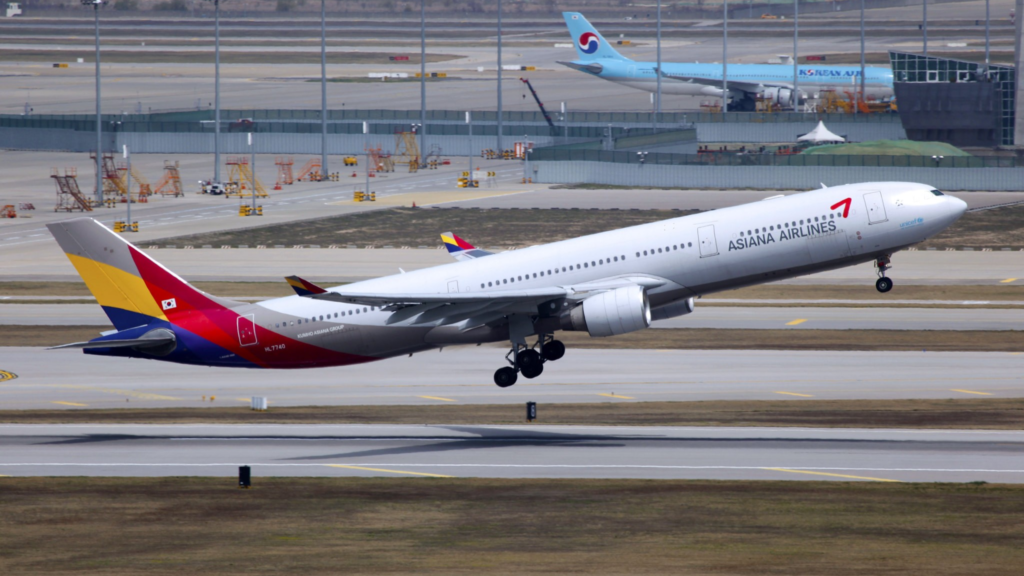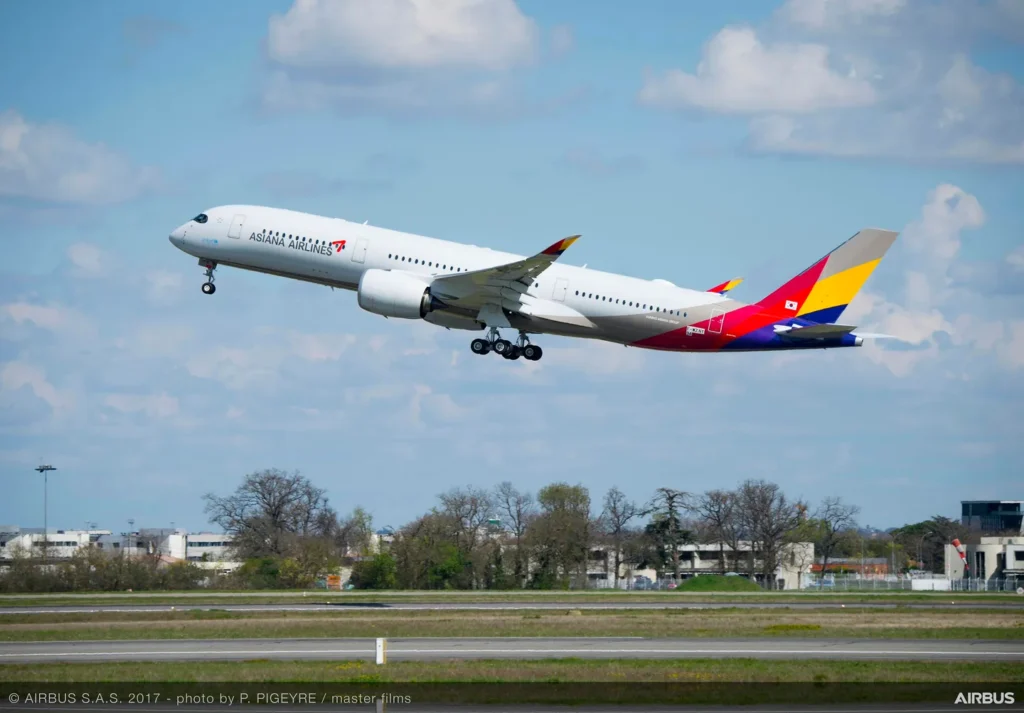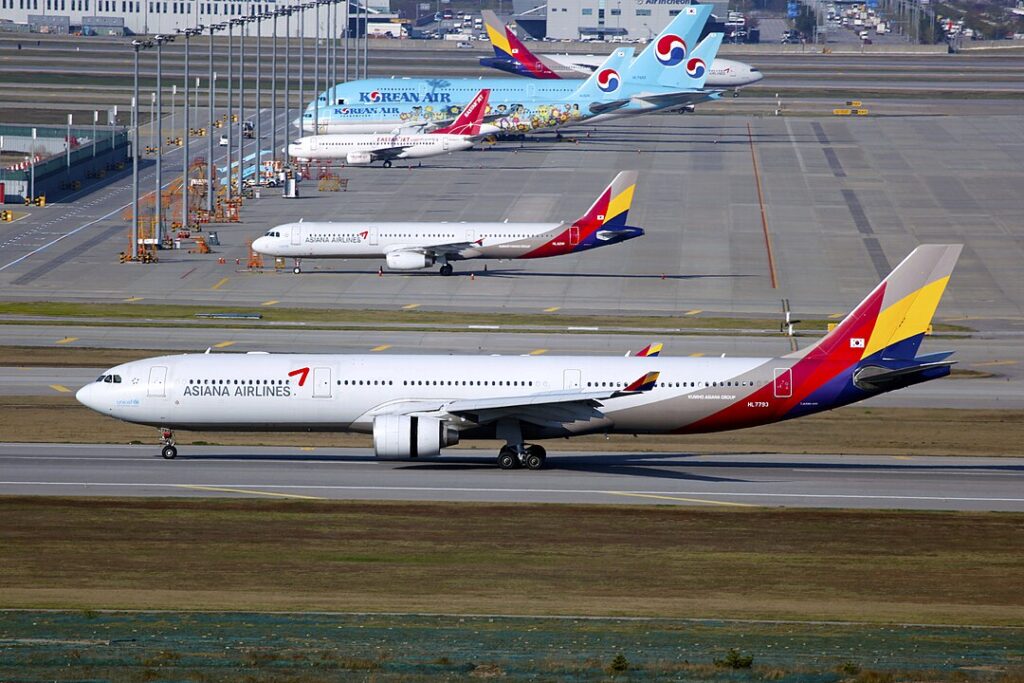SEOUL- An Asiana Airlines (OZ) flight bound for Narita, Japan, returned to Incheon International Airport (ICN) after an engine failure shortly after takeoff on June 21, 2025.
The Seoul–Narita route flight, OZ108, declared an emergency and landed safely after thick smoke and flames were reported from the aircraft’s left engine.

Asiana Emergency Landing in Seoul
Asiana Airlines flight OZ108, operating from Incheon International Airport (ICN) to Narita International Airport (NRT), departed at 6:29 p.m. local time.
The Airbus aircraft experienced engine trouble within minutes of takeoff and returned to Incheon for an emergency landing at 7:29 p.m.
A loud explosion-like sound was heard shortly after departure, according to eyewitnesses, followed by visible flames and heavy black smoke from the aircraft’s No. 1 (left) engine. The issue triggered a “full emergency” response from the Seoul Regional Office of Aviation.
Emergency response teams, including firefighting units stationed at ICN, were immediately mobilized and deployed to Runway 4, where the aircraft made a safe landing approximately one hour after departure. There were no reported injuries.
Passengers Safely Evacuated
The aircraft was carrying a total of 263 individuals, comprising 239 passengers and 24 transit passengers. Following the incident, Asiana Airlines (OZ) arranged overnight accommodations for all affected travelers and began rescheduling efforts for an early-morning departure.
The airline issued a statement confirming that initial assessments pointed to a malfunction in the No. 1 engine. Authorities have not yet disclosed the engine model or aircraft type, though a full investigation is underway.
An official from Incheon Airport stated that technical teams are working to determine the root cause of the failure. Aviation safety regulators are also involved in the inspection, as is standard protocol following an in-flight emergency.
The aircraft has been grounded pending further inspection and maintenance clearance. No further incidents were reported during or after the emergency landing.

Similar Incident
An Asiana Airlines (OZ) Airbus A350-900 operating flight OZ212 from Seoul Incheon (ICN) to San Francisco International Airport (SFO) triggered an altitude alert during final approach on February 23, 2025.
The aircraft descended below the proper glide path to runway 28L, prompting San Francisco ATC to issue an urgent warning. The crew initiated a go-around and later landed safely on a second attempt.
According to LiveATC communications, flight OZ212 received a critical altitude call from the tower controller as it approached runway 28L. The controller advised the pilots to verify their altitude and provided the altimeter setting of 30.26 inHg. The urgency of the alert suggested a significant deviation from the standard glide slope.
The aircraft was approximately 2.7 nautical miles from the runway near Coyote Point when the alert occurred. Although exact altitude data is not publicly confirmed, flight tracking suggests the A350 climbed to 4,000 feet before being instructed to level off at 3,000 feet.
The crew executed a textbook go-around and successfully landed around 15 minutes later, avoiding any operational or safety incidents.
San Francisco International Airport (SFO) reported clear weather and good visibility during the incident. There were no meteorological factors contributing to the low approach.
The Federal Aviation Administration (FAA) and South Korea’s Ministry of Land, Infrastructure and Transport may open an investigation to determine why the descent deviated from the glide path and whether the flight crew was aware of the anomaly before air traffic control intervened.
Echoes of the 2013 Asiana Flight 214 Crash
This incident drew immediate comparisons to the crash of Asiana Airlines Flight OZ214 in 2013, also on approach to SFO’s runway 28L. That flight, a Boeing 777-200ER, descended too low, striking the seawall due to pilot error and mismanagement of the aircraft’s descent systems.
Three passengers died and over 180 were injured in that crash. Following the tragedy, Asiana Airlines retired the OZ214 flight number and reassigned the route as OZ212, which is the same flight involved in the February 2025 event.
While no injuries occurred in the recent case, the circumstances have revived concerns about approach monitoring, situational awareness, and training for international carriers operating into complex U.S. airspace.
Stay tuned with us. Further, follow us on social media for the latest updates.
Join us on Telegram Group for the Latest Aviation Updates. Subsequently, follow us on Google News

